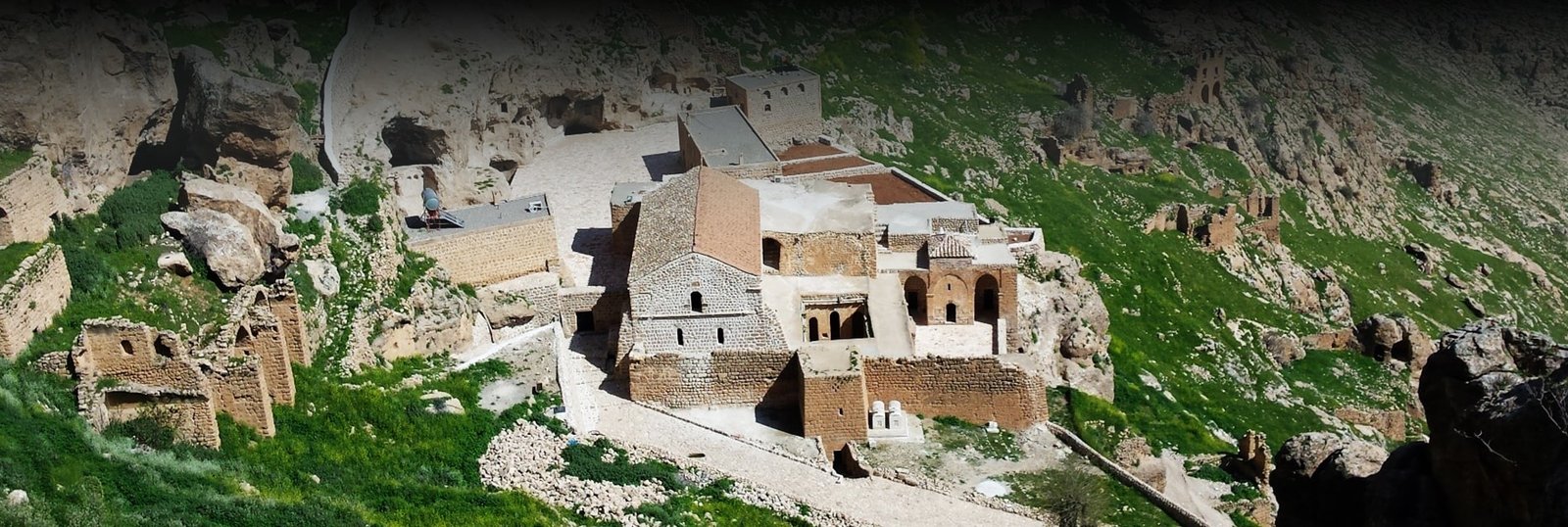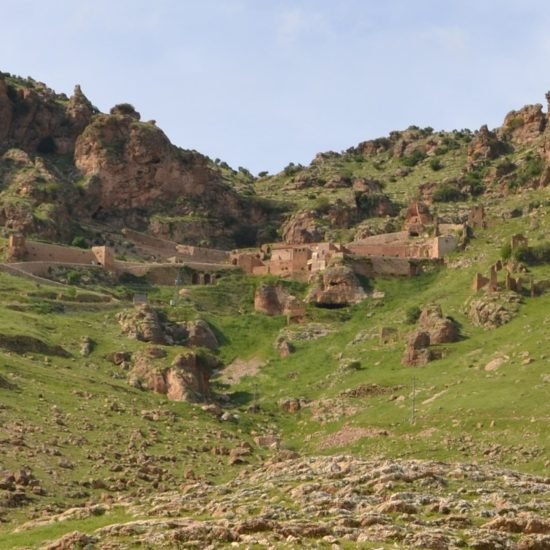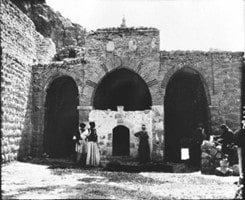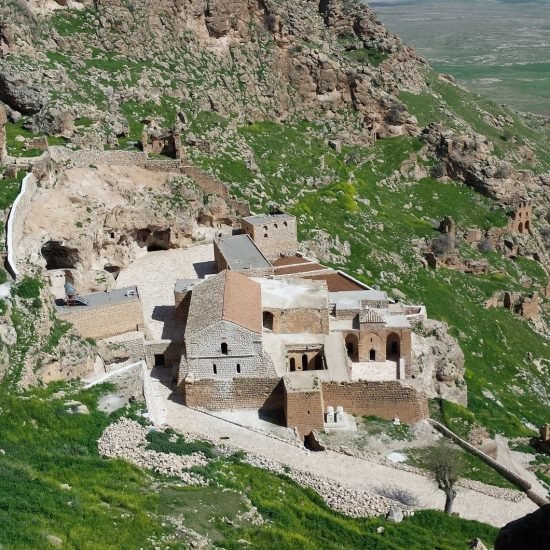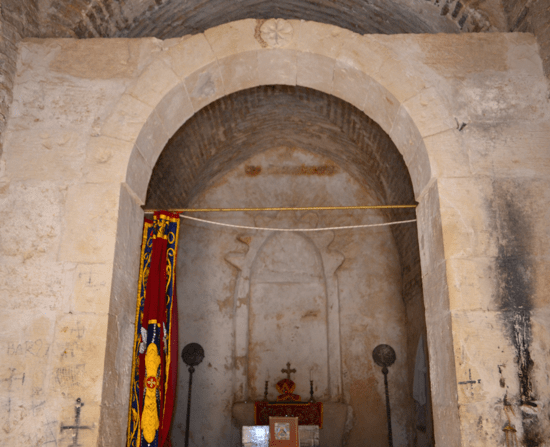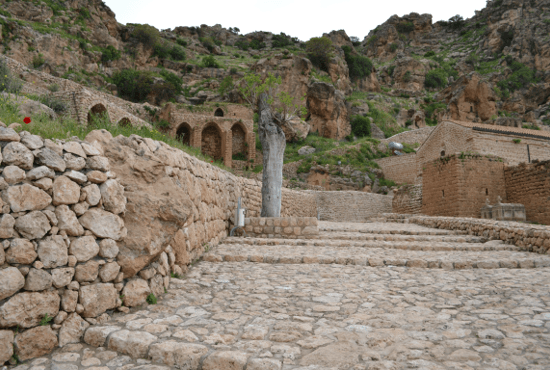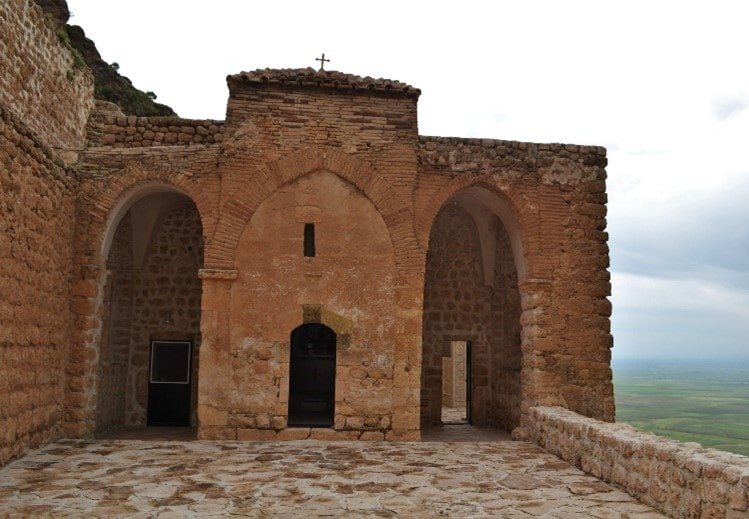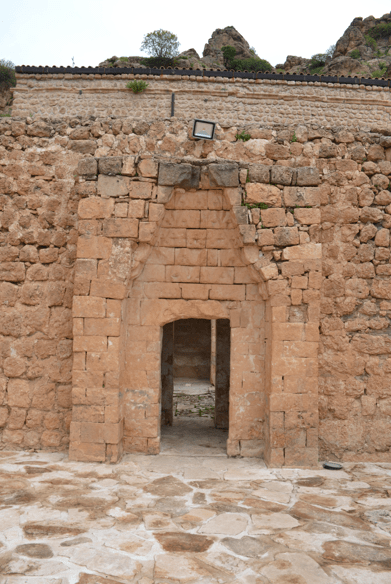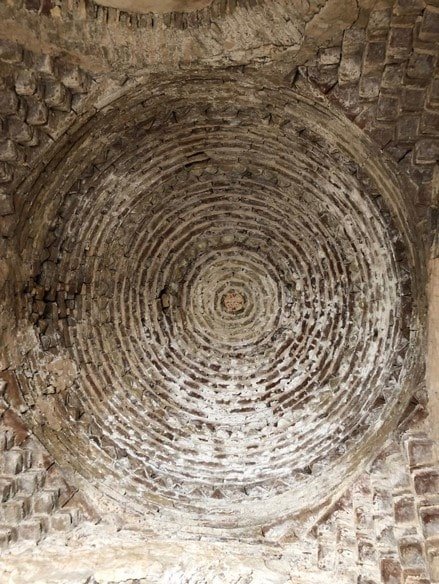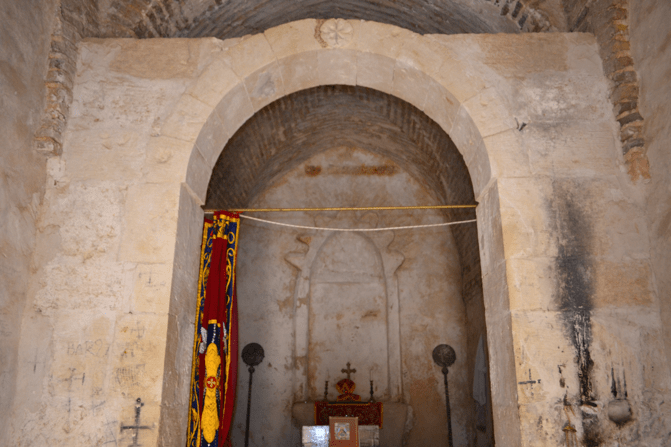The Monastery of Mor Augin
per person
The monastic complex of Mor Augin lies high above the Plain of Nusaybin among the steep cliffs of Mount Izlo, part of the historical region of the Ṭūr ‘Abdīn and currently located in the Turkish Province of Mardin.
According to the local tradition, this is the most ancient monastery in the area, founded in the early fourth century, when monks, the pioneers of Christian mission outside the cities, pushed the frontiers of Christendom into the hinterland of Nisibis, the capital of the roman province of Mesopotamia (197-363 CE). In spite of the remoteness in which they sought peace to pursue a spiritual life, the monks of Mor Augin were hospitable to wayfarers along the ancient trade route which passed below their monastery (Hollerweger, Hans, Andrew Palmer, Sebastian Brock, and Sevil Gülçur. Lebendiges Kulturerbe : Turabdin : Wo Die Sprache Jesu Gesprochen Wird. Freunde des Tur Abdin, 1999: 288-289).
After the cession of Nisibis to the Persians in 363 CE, the frontier between them and the Romans was redrawn across the crest of Mount Izlo. Mor Augin was now in Persia and the monks who lived there were members of the Persian Church, “the Church of the East” (Hollerweger et al, 1999: 295). The latest evidence of East Syrian occupation at Mor Augin is the Berlin Syriac MS 31, which was written at that monastery in 1621 (Sebastian P Brock, «Notes on Some Monasteries on Mount Izla.» Abr-Nahrain, vol. 19 1980: 4). At some time in the 150 years that followed it was abandoned (Andrew Palmer, The Seventh Century in the West Syrian Chronicles. Liverpool University Press, 1993: 9–11), to be re-occupied under the Syrian Orthodox’ sphere of influence (Western Syriacs), eventually. In 1915 during the Seyfo, the Assyrian/Syriac Christian genocide, the monks witnessed the destruction of Syriac villages in the plains below. The monastery was also affected by violence. In the twentieth century, there were more than 20 monks in the monastery and the last monk passed away in 1968. Subsequently, in April 2010, the Patriarch of Antioch, H.H. Ignatius Zakka I, appointed Fr. Joachim Raban as the abbot of Mor Augin Monastery. Fr. Joachim has carried out the restoration works of some of the Monastery buildings.
FORMAL ANALYSIS
The main complex is protected by high walls and to the west by a door-building. The many ruins bear witness to the past extension of the monastery (Hollerweger et al, 1999: 289). East of the monastery’s courtyard, surrounded by a cloister, is a large burial chamber (beth qadishe) with the tombs of Mor Augin’s seventy disciples. North of this is a lightless room containing the tomb of the founder himself, of his sister and of other members of his family (Hollerweger et al: 1999: 293). On the north side of the courtyard is the main church, which is long from east to west, unlike the monastic churches’ typology of the Ṭūr ‘Abdīn. The chapel of Mart Maryam is roofed by a little brick dome, in the architectural style locally developed in the eight century (Keser Kayaalp, Elif. ‘Church Building in the Ṭur ʽAbdin in the First Centuries of the Islamic Rule’. Authority and Control in the Countryside: From Antiquity to Islam in the Mediterranean and Near East, 6th-10th Century, 18 October 2018: 199).
Due to repeated periods of abandonment, the complex has undergone numerous renovations up to the recent period. Apart from the surrounding remains of fortifications and possibly the general plant, in fact, Mor Augin Late Antique facies remains unknown, for either study of its masonry structures or a proper archaeological investigation is still missing.
- THE MONASTERY OF MOR AUGIN ON MOUNT IZLO © PHOT. VIRGINIA SOMMELLA, 2019
- THE MONASTERY OF MOR AUGIN ON MOUNT IZLO
- MOR AUGIN MONASTERY FROM EAST © PHOTS. VIRGINIA SOMMELLA, 2019
- MOR AUGIN, TERRACE SOUTH OF THE MAIN COURTYARD, FACING THE SOUTHERN PLAIN, ACCESS TO THE CHAPEL OF MART MARYAM © PHOTS. VIRGINIA SOMMELLA, 2019
- MOR AUGIN, TERRACE SOUTH OF THE MAIN COURTYARD. © PHOT. GERTRUDE BELL, 1909
- MOR AUGIN MONASTERY © PHOTS. WORDPRESS.COM, 2016
- ENTRANCE TO THE COURTYARD. © PHOT. VIRGINIA SOMMELLA, 2019
- THE BRICK DOME IN THE CHAPEL OF MART MARYAM. © PHOT. VIRGINIA SOMMELLA, 2019
- ALTAR IN THE MAIN CHURCH © PHOTS. VIRGINIA SOMMELLA, 2019
- ALTAR IN THE MAIN CHURCH © PHOTS. VIRGINIA SOMMELLA, 2019
- COURTYARD. © PHOT. VIRGINIA SOMELLA, 2019
- INTERNAL STAIRS TO THE COURTYARD © PHOT. VIRGINIA SOMELLA, 2019
Información de la localidad
The Monastery of Mor Augin
| Other monuments and places to visit | Nusaybin archaeological excavation (Roman forum and basilica); Dara archaeological excavation (Roman city); Mor Yuhannon monastery; Mor Abrohom monastery. |
| Natural Heritage | Hilly region at the southern edge of the Anatolian Plateau, facing the Mesopotamian Plain. |
| Historical Recreations | |
| Festivals of Tourist Interest | |
| Fairs | |
| Tourist Office | |
| Specialized Guides | |
| Guided visits | |
| Accommodations | No hostel in the monastery. Hotel or bed and breakfast in the cities of Nusaybin (35 min by car), Midyat (1 hour by car) or Mardin (1 h 20 min by car). |
| Restaurants | Bahoz Cafe Restaurant,Beyazsu ( Beyazsu, Midyat Nusaybin Yolu, 47300 Nusaybin/Mardin, TR), Divan Restaurant (8 Mart, Cumhuriyet Cad. No:5, 47300 Nusaybin/Mardin, TR). |
| Craft | |
| Bibliography | T. A. Sinclair, Eastern Turkey: An Architectural and Archaeological Survey., 4 vols (Pindar Press, 1987). Andrew Palmer, Monk and Mason on the Tigris Frontier: The Early History of Tur `Abdin (Cambridge England ; New York: Cambridge University Press, 1990). Hans Hollerweger et al., Lebendiges Kulturerbe : Turabdin : Wo Die Sprache Jesu Gesprochen Wird (Freunde des Tur Abdin, 1999). Elif Keser Kayaalp, Church Architecture of Late Antique Northern Mesopotamia, Oxford Studies in Byzantium (Oxford, New York: Oxford University Press, 2021). Keser Kayaalp, Elif, ed. Syriac Architectural Heritage at Risk in TurʿAbdin. Istanbul: KMKD, 2022. |
| Videos | |
| Website |
| Monument or place to visit | The Monastery of Mor Augin |
| Style | Remains of Late Antique fourth century local masonry structures, later medieval addictions. |
| Type | Fortified monastic complex. |
| Epoch | 4th century – present. |
| State of conservation | Good condition |
| Degree of legal protection | |
| Mailing address | Eskihisar Mahallesi, Nusaybin/Mardin 47300 TR. |
| Coordinates GPS | 37.167739°N 41.408318°E |
| Property, dependency | |
| Possibility of visits by the general public or only specialists | Accessible to public visitors. |
| Conservation needs | No current conservation need. |
| Visiting hours and conditions | Open from 8:00 a.m. to 6 p.m, closed on Sunday. |
| Ticket amount | Free admission. |
| Research work in progress | Restoration work by Fr. Joachim Raban (2010), with the support of Mor Gabriel Monastery and SURYOYE in Europe. Standing monument survey (2012), Proj. Mapping Mesopotamian Monuments of Columbia University. |
| Accessibility | To reach the entrance of the complex visitors will have to walk uphill for approximately one kilometer: cars are rarely admitted to the monastery entrance and this part of the route is not accessible by large tourist bus. |
| Signaling if it is registered on the route | Not yet registered. |
| Bibliography | Sebastian P Brock, "Notes on Some Monasteries on Mount Izla." Abr-Nahrain, vol. 19 (1980): 1-19. Hans Hollerweger et al., Lebendiges Kulturerbe : Turabdin : Wo Die Sprache Jesu Gesprochen Wird (Freunde des Tur Abdin, 1999), 289–95. Palmer, Andrew. ‘La Montagne Aux LXX Monastères. La Géographie Monastique Du Tur ’Abdin’. In Le Monachisme Syriaque, 169–259. Études Syriaques 7. Paris: Librairie orientaliste Paul Geuthner, 2010: 9-11. Elif Keser Kayaalp, ‘Church Building in the Ṭur ʿAbdin in the First Centuries of the Islamic Rule’, Authority and Control in the Countryside: From Antiquity to Islam in the Mediterranean and Near East (6th-10th Century), 18 October 2018, 199. |
| Videos | Youtube Youtube |
| Information websites | facebook.com wikipedia.org morauginmonastery.wordpress.com bbc.com |
| Location | Located on the steep cliffs of Mount Izlo, 20 km N-E of Nusaybin (Prov. of Mardin, Turkey) |


